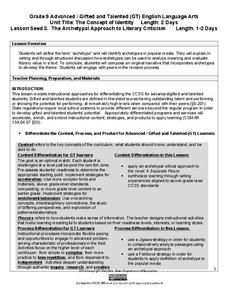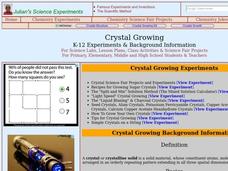The Science Spot
Flower Basics
Learn about plants and pollination with a worksheet about the parts of a flower. After labeling the anatomy of a flower using a word bank, kids explain the difference between self-pollination and cross-pollination, and unscramble the...
Garden Earth Naturalist Club
Parts of a Flower! Flower Dissection
Sometimes the best way to learn about plants is to see the different parts of a plant yourself. Groups of learners dissect flowers to answer questions about what they observe and what they wonder about their flower.
Maryland Department of Education
The Concept of Identity Lesson 3: The Archetypal Approach to Literary Criticism
As class members continue their study of approaches to literary criticism, readers examine the symbolism and archetypal patterns in John Knowles' A Separate Peace, and how these parallels are used to develop a theme in the story.
Ask a Biologist
The Many Faces of Ants
Though they be but little, they are fierce! Young biologists read about eight different species of ants, and discover how the anatomy of their heads can explain the way they live and what they eat.
Curated OER
Fertilizers
Students examine the nutrient makeup in fertilizers. In this plant nutrient instructional activity students see the effects of common fertilizers on plants.
Curated OER
Plant Diversity and Distribution
Students construct a defined plot on school grounds and observed patterns in plant life. They count trees, shrubs, cacti and record on a data sheet. They compare data and generate a plant diversity overlook for their school.
Curated OER
Prairie Find Outdoors
Students take a field trip to a local prairie. Using identification books, they identify various forbs and grasses in the prairie. As a class, they discuss the importance of forbs and grasses to the ecosystem and review the various types...
Curated OER
Idaho Vocabulary
For this Idaho worksheet, learners match vocabulary words about Idaho to their descriptions. Students match 10 words to their descriptions.
Curated OER
Exploring Idaho
In this exploring Idaho worksheet, 4th graders complete ten multiple choice statements about interesting places in the state of Idaho.
Curated OER
Raising Plants
Learners investigate the life cycle of plants by growing their own in class. In this botany lesson plan, students practice using plant vocabulary while they grow their own Wisconsin Fast Plants. Learners collaboratively build a light...
Curated OER
1st Grade - Act. 17: Observing Plants Through a Journal
First graders observe plants and write and illustrate what they have learned in their discovery journal.
Curated OER
Eating Plants
Students identify parts of a plant. In this life science lesson, student groups locate the leaves and fruits on vegetables, then find the roots. Lesson includes extension activities and background teacher information.
Curated OER
Bird Bodies
Students read about and explore the different types of birds. They discuss how all birds are alike and what makes some different from the others. They experiment picking up "food items" using different tools that represent different...
Curated OER
Pollinators and Wildflowers
Learners explore how plants depend on pollinators to reproduce. In this pollination lesson students dissect a local flower and collect and identify pollinating insects.
Curated OER
WET Science Lesson #3: Comparison of Aquatic and Terrestrial Plants
Elementary life science explorers compare and contrast aquatic and terrestrial plants (elodea and soybeans) in a Venn diagram. Some background information is provided to support direct instruction, and general instructions are provided...
Curated OER
RAINSTICKS
Students create a rainstick from recycled materials and begin learning about the "nature" of the rainforest.
Curated OER
Cells, Cells, Cells
Students explore plant and animal cells. Using household items, students create a three-dimensional model of a plant or animal cell. Students identify and label each cell part.
Curated OER
What is Cacao?
Learners use the Internet to learn about the cacao plant. In this plants instructional activity, students complete a KWL chart on chocolate, learn about cocoa plants and discuss the parts of a plant. Learners use the Internet to learn...
Curated OER
Crystal Growing
Students explore the different phases of a crystal. In this mineral lesson students grow their own sugar crystals using a sugar recipe.
Curated OER
Plants And Pollination
Students describe sexual reproduction in plants, including the process of pollination, how insects assist in pollination, and how pollination differs from fertilization. They also explore the importance of honey bees to Arizona agriculture.
Curated OER
Feudal Japan - It's All Japanese to Me!
Students research the culture of feudal Japan. They discuss shoguns, emperors and clans. They practice writing Japanese letters.
Curated OER
Exploring Bloom's Taxonomy Through Eric Carle Collage Technique
Students participate in shared readings of Eric Carle's books and investigate the art and story elements. They create a collage and answer questions.
Curated OER
Ceramic Draped Slab Masks
Students will compare and contrast various forms of artistic expression associated with specific groups of people, geographic regions, or time periods. Investigate processes and beliefs used by various cultures and institutions, past and...
Curated OER
Landforms
Students study how landforms affect all aspects of a community. Students work in groups to identify landforms from other works of art. In cooperative groups Students select a work of art depicting a particular land form and create a poem.

























